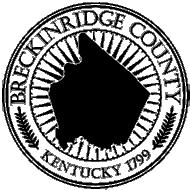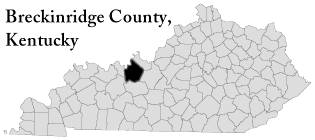 |
USGenWeb Archives Project Breckinridge County, Kentucky |
 |
 |
 |
 |
 |
USGenWeb Archives Project Breckinridge County, Kentucky |
 |
 |
 |
 |
THESE
ARCHIVES BUILT BY YOUR
CONTRIBUTIONS.
PLEASE CONTRIBUTE TODAY!
New
Easy to use Submission
Forms!
This Page Updated Monday, 11-Apr-2022 20:27:49 EDT
| BRECKINRIDGE COUNTY, KENTUCKY |
| AREA COMMUNTIES OF THE PAST AND PRESENT |
| IRVINGTON |
George Bandy came to Breckinridge County in the early
1800’s, and settled on his land grant, a few miles
west of the present site of Irvington.
This land grant lay
from about where Highway 86 intersects with U. S. 60 Highway
almost to the city limits of Irvington.
Mr. Bandy was one
of the earliest residents of the Irvington vicinity.
It
could well have been he with whom James Audibon spent the night
when on his trip from Henderson to Louisville.
He told
in one of his books of spending the night in this immediate
vicinity near Sinking Creek, where he saw the greatest
concentrated
migration of passenger pidgeons that he had seen anywhere. This
was in the fall of the year and these birds were
literally rolling over each other like a giant tidal wave. It
was frightening to see them coming as they gleaned the beech
mass from the floor of the virgin beech forest.
It was at
this place where he recorded having seen them roost in the trees
in such numbers that the limbs were broken from the trunks.
Possibly never in the history of mankind has species of
God’s creatures been so wantonly ravaged and destroyed to
the point of complete annihilation and extinction as was the
passenger pidgeons of America. Sometimes
I am made to think
that, “If God doesn’t punish America for its sins,
He
will have to apologize to Sodom and Gomorrah.”
At this period in Breckinridge County history, homes were
few and
far between. The
Bandy settlement
was sandwiched between Bewleyville and Webster.
The old
homestead was on the east side of Sinking Creek about
one mile, where the old house still stands, and a portion of the
original land of George Bandy is still in the family.
At
present Ginger Wilson owns the old home place.
He is the
son of Nancy Bandy Wilson, grandson of Ginger Bandy,
great-grandson of Thomas Bandy, great-great-grandson of Richard
Bandy II and a great-great-great-grandson of George,
who first settled there. It
is Ginger in whom is coagulated
all the traits of the Bandy Clan.
He is one of our
county’s
best farmers at age 32. He
is a graduate of the University
of Kentucky, teaches school in Breckinridge County High
School, sells insurance, coaches basketball, sings at funerals,
weddings and other special occasions, and can whip any two
ordinary
men in a fair fight. He
is a composite; and will probably
dip his oar in politics; and I think Kentucky could not do
better.
Soon after the trains had begun to make regular runs, a
Mr.
Blanford from the Bewleyville area had heard so
many wild tales concerning this Iron Horse, he decided to make
the trip over to Irvington to see one.
Mr. Blanford was
in his late eighties and eye sight was not too good.
When
he arrived at the depot the train was there.
He rushed
feebly out on the platform to look her over.
Mr. McCracken
got the old gentleman a chair and set it on the platform where
Mr. Blanford sat. Several
men were standing on the flat car
when the train pulled out. Somehow
Mr. Blanford got
the impression that he was on the train and when the train began
to go he yelled excitedly, “Let ‘er rip, son. I’ll
ride ‘er to
Henderson, come hell or high water!”
This story shows
something of the excitement the railroad created.
The Louisville, Hardinsburg, and Western Railroad known in
this
area as the Branch Line, ran from Fordsville to
Askins, to Vanzant, to Rockvale, to Falls of Rough, Glen Dean,
McQuady, Kirk, Hardinsburg, Harned, Garfield, and connected
with the main line at Irvington. This
added to the business
and growth of the community. This
track was not built
to carry heavy loads so was never a paying proposition.
It
was granted permission to discontinue services and on June
15, 1941, the last train wobbled over the Branch Line into
Irvington.
One of the first essentials of any up-to-date town, was a
good
mill. Recognizing
this need, and the lucrative
opportunity it afforded, Jessie and David Boyd, from another part
of the state began to locate a building lot for this purpose.
They purchased the
lot and the mill was built. They
operated it for a few years then sold out to J. W. Piggott and
R. M. Jolly. These
two men operated the mill for years and
served the country for miles around.
After Mr. Jolly died,
Mr. Piggott continued in the business for several years, then
sold out to Mr. John Cook. Mr.
Cook operated the mill for a
few years, until it was destroyed by fire.
Later on the
present building was erected. Mr.
Trent and Simmons own
and operate a lumber business there at the present.
These
country mills played an important part in the development of our
county. Before the
days of modern transportation, it was
almost necessary that there be a mill of some sort within donkey
range, and we had them. Sinking
Creek, North Fork, Clover
Creek, and Rough River, each aided by the ingenuity of our
early settlers, provided the power for manufacturing the staff of
life right in the community where it was produced and consumed.
This is an identifying feature which characterizes the
American
people. Since the
settlement at Jamestown
in 1607, when the American people had to have
something—somebody made it.
And to the millers and
blacksmiths—we
owe much to the inventive ingenuity of our nation.
These
were men who did not exploit their neighbors, but took pride in
their work, and offered a service to their communities.
Prior to the coming of the railroad and before Irvington
was in
existence, the mail service was one of the major
problems. For years
the mail was hauled by stage coach from
Hardinsburg to Muldrough through the old covered
“Dent’s
Bridge” and by way of Bewleyville.
There was another
mail route that went by horse back, from Stephensport through
Webster and Hayesville, to Garrett.
The trip could be made
in two days unless the creek got up too high.
There
were other routes at times but the post office at Bewleyville,
Webster, and Hayesville served the public.
In the eastern end of Breckinridge County, about half way
between
the two much older communities of Bewleyville and
Webster, lies one of the most fertile and beautiful valleys to be
found anywhere in the Commonwealth.
The valley and hills
surrounding it were sparsely populated, with farm dwellings
located at intervals where sometimes the nearest neighbor was
more
than a mile away. The
Jollys, Jordans, Bennetts, Bandys,
Adkissons, McCoys, Robertsons, and Washingtons were
some of the early settlers of this section.
These were good
and prosperous farmers, but from 1800, up until the steam
boats began plying the waters of the Ohio River near the middle
of the eighteen hundreds, there was never, in any county, a more
energetic, patriotic, or less tidy people to be found.
Isolation,
was the most under statement since Noah said, “It looks like
rain.” There
were no railroads, no highways, and no
river travel except one way, and civilization lay 2000 miles down
stream.
The only clothes
or other comforts of civilization to be
had, must come over the mountains by oxcart.
It was not
until
the coming of the steam boat that manufactured items penetrated
the wilderness to this section of Kentucky.
The spinning
wheel and loom, at the hands of the women folk who labored
endless hours was the source of wearing apparel.
It was
from
this period the statement “A man’s work was from
sun to
sun, but a woman’s work is never done,” originated.
A truer statement
was never made. The
husband could wear out his clothes
about as fast as his wife could make them.
The chore of
rearing
the children, often eight or ten, and cooking without Corning
Ware, or doing the laundry on a scrub board with water heated in
iron
kettles in the back yard, using lye soap, which they made
themselves, made the women folk a pretty busy schedule.
Bridge
parties or Homemakers and other women’s clubs are modern
inventions.
By the late eighteen hundreds, this community was a great
wheat
producing region. Nearly
every farmer
grew wheat for both home consumption and money crop.
This
wheat had to be transported to the river for shipment to market
and the portion kept for home consumption was taken to the water
mills to be ground into flour. Several
of these water mills
were located near this community on Sinking Creek.
Tobacco
was also taken to Brandenburg in hogsheads to be shipped to
market. About this
time, in the eighteen eighties, talk of
a railroad through the community brought to the farmers great
hope for
the future. Two men
of the community saw the necessity of
having a modern town located where it could serve the local
needs.
These were R. M.
Jolly and Ed Bennett. They
purchased two tracts of land, one from Thomas McCoy, Sept. 20,
1887. Consisting of
144 acres for $2,837 and one from James
B. Robertson of 171 acres for $4, 013, these two tracts
constituted the land where Irvington lies.
It is difficult for us, in 1966, to visualize the
importance of a
railroad to the people of this inland community in 1888.
The hilarity of
the farmers over the coming of the
“Iron Horse” was a universal jubilee, lost in
history,
save to one who might
have been hopelessly trapped; and saved by a miracle.
When the Louisville, St. Louis, and Texas Railroad finally
became
a reality, the town plot of Irvington was lain out
and recorded in the Clerk’s Office in Hardinsburg, Kentucky
in January, 1889. The
streets were named running south to
north;
First, Second, Third, and Fourth.
The streets running east
to wet beginning at the south were: Grand, Maple, Walnut and Arch
Avenues. The town
north of the railroad was almost
altogether settled with Negroes.
The railroad was built in 1887 and 1888.
The first train
ran through the valley in 1888. This
road was
a pet project of the McCracken brothers of New York.
W. V.
McCracken was president; A. M. McCracken the superintendent;
J. K. McCracken was general freight agent; H. M. McCracken was
road master, and C. W. McCracken was chief engineer—making
it
largely a family affair.
The new school had an inside gymnasium and Irvington has
always
been one hard team to beat. One
of the
healthiest rivalries to be found anywhere existed between
Irvington and Hardinsburg. When
these two teams met on the
hardwood
during the season you could expect 32 minutes of excitement equal
to the “Gingham Dog and the Calico Cat”; but when
an
invader from
some other part of the state came around they were in each others
corner.
In 1965, the academic pressure was so great and because of
poor
facilities in both Hardinsburg and Irvington, the two
schools were disbanded and a new million dollar high school was
built at Harned and the two former high schools consolidated into
one.
A better or more
modern school may not be found anywhere
in Kentucky and no longer will we have to send our children to
college
unprepared.
The religious life is one of the first thoughts and a dire
necessity to any community. Before
the town of Irvington
sprang up, these country people worshiped in near-by communities.
There was a Baptist Church at Sandy Hill; a Methodist
Church
at Webster; both Baptist and Methodist at Bewleyville, and a
Catholic Church at Mount Merino.
The Baptists built a church in town in 1892, and replaced
it with
the present one in 1918. The
Methodist Church
was built in town in 1898, and was dedicated July 2nd,
of the same year by the Rev. Sam Jones.
The present
Methodist Church was
built in 1938. The
Catholic Church at Mount Merino was
first built in 1854. This
was replaced by a new building in
1899,
in the same place. In
1933, the old Mt. Merino church was
discontinued and the congregation moved to the new church which
was
built in Irvington. Prior
to the church at Mt. Merino, a
boy’s school was in operation from 1840-1846.
The
Negro population
of Irvington have maintained through the years, both a Baptist
and a Methodist Church.
The town, in general, has always maintained a high
religious and
social standard.
In 1902, the Spotsville Iron and Gravel Co. opened up a
rock
quarry near Webster. This
Company was composed,
mainly, of men from Cloverport. All
work was done by hand
labor which required the employ of a lot of men, usually around
50 to 75.
In 1910, the Webster Stone Co. was opened up nearer to
Irvington.
This was by the same company as the other.
After a few years
several business men of Irvington bought
and ran the quarry. Later
the business was sold to the
Kentucky
Stone Company which has continued to operate until the present
time. Most of the
roads in our county were built, and the L
and N
Railroad bed has been maintained, from this quarry.
Throughout
the years this business has had a large payroll and contributed
much
to the town and surrounding community.
Until 1917, the old kerosene lamps could be seen
flickering in
the windows. To
those of us who remember cleaning
the chimneys and trimming the wicks in such a fashion as to give
the desired shape and amount of light, there is a sentimental
sort of sadness
about their having to go. A
wick trimmed to give a rounded,
oval-shaped flame created more light if one wished to read or
study his
lessons; but, the young lady expecting a suitor trimmed the wick
in a sort of V shape so that there was a long spire of a soft,
flickering, dim light
that left the room largely in shadows.
Ever since Delilah
took Sampson to the barber shop, the fairer sex of every
generation have
invented ways of trapping their victims.
In 1917, C. L.
Winn secured a franchise to install a lighting system.
When
the demand
became greater for more electricity other than lights, a Utility
Company bought the Winn franchise in 1927, and installed larger
power units to
meet the needs of the town. In
1939, the R. E. A. took over
the control of all electricity in the county and power was made
available to
both town and country people alike.
Prior to 1887, livestock had to be driven to Brandenburg
or
Stephensport to be shipped to market.
During this period
there were stock traders or buyers who visited the farms and
bought the livestock and made these drives to market their
business. Some
of these men were Dan Brooks and Alex and Dick Hardaway. Later
these men became associated with the Bourbon Stock Yard in
Louisville, Kentucky. One
of the last of these men who
traveled through the country to buy cattle was Felix Carden.
The coming
of good roads and the trucks, that could go right to the barn and
pick up the livestock, and the radio as a means of keeping in
constant touch
with the stock market in Louisville, put these men out of
business.
Immediately after the town lots were sold, businesses
began to
spring up. Within a
few years there were stores, shops
of different kids, a drug store, and even the saloon with the
proverbial swinging doors.
The town’s business, as well as the farmers, now
needed a
place to take care of their finances.
In 1898, Mr. E. H.
Shellman organized a bank. He
and Miss Mary Cromwell, who
was his “Board of Directors” operated the bank and
served the people
well for over fifty years. Sound
business practices and
good management helped him to ride out the great Depression of
the thirties without
suffering the fate of thousands of similar institutions all over
the United States. This,
too, is a tribute to the Irvington
community, because
sound business on the part of the banker is to a greater or
lesser degree, dependent upon the quality of people with whom he
does business.
In 1903, the First State Bank was organized with W. J.
Piggott as
president and John R. Wimp vice-president.
This
bank, like Mr. Shellman’s, has been reliable throughout the
years, and has made satisfactory growth.
The First State
Bank is now
well over a million dollar institution.
On August 15, 1906, the first R. F. D. Mail Route out of
Irvington was established. Mr.
Oscar Dowell was carrier on
this route; and in 1913, it became ultra modern when Mr. Dowell
started carrying the U. S. Mail in a Model T Ford.
When the
children
and grown ups alike, who lived along Mr. Dowell’s route
heard his Model T coming they would drop their hoes or whatever
tools with which
they might be working, and run like rabbits to the road to see
him whiz by, leaving a cloud of dust behind.
He was a dare
devil, and often
traveled at break-neck speed, up to 20 and sometimes 25 miles per
hour.
One of the earliest schools in the community was located
on the
ridge north of Highway 60 near Sinking Creek.
It was
known as the Bandy School and was constructed of logs.
The
first school house in Irvington was a one-room affair which was
soon
outgrown and a more adequate, three-room one was erected on the
east end of town. There
was no high school, as we know them
now;
but a Normal School was held where they offered preparatory
courses for prospective teachers.
The community saw the
need for a better
educational opportunity for its children and a drive was made for
funds to help build a high school.
It was erected on the
present school
ground, but burned down in 1937. The
present school was
built in 1938 and the Agricultural Building was added in 1941.
Since 1917, the Irvington Herald has been serving the
people of
Breckinridge County. This
paper made its first
publication Feb. 8, 1917. It
was started by Paul McNull,
who after two months sold out to Mr. J. W. Willis.
The
paper was
under his management for twenty-eight years.
In 1945, it
was sold to its present owner, Mr. George M. Wilson.
For a little town that came into being at a late date,
Irvington
has had its part of the politicians.
Mr. R. M. Jolly was
elected to the state senate from this district; and our
legislature has been represented by E. H. Shellman, Dr. S. P.
Parks, C. A. Van Lahr, and
J. W. Simmons. Breckinridge
County and the state at large
may well be proud of these men.
A few years ago Highway U. S. 60 was straightened out from
Irvington to Grey Hampton, leaving Brandenburg several
miles to the north. This
brought Irvington much closer to
Louisville and Fort Knox. Since
the new road was built
several new
businesses have been built on the south side of town to be on the
new road. The Green
Valley Restaurant and Motel are as nice
as
may be found. Across
the highway to the south is a new
housing section. All
of these homes are either brick or
Bedford stone
and are in the class that would categorize the upper middle class
of society.
Mr. Trent is largely responsible for this beautiful
subdivision
which is of the type that would catch the eye or any tourist and
cause him to remember and comment on it after his vacation is
ended. The large
lighted cross which one cannot help seeing
as he passes
through town after dark, is a monument to Mr. Trent.
It was
built by his sons and is lighted and maintained by the city of
Irvington.
At present, other than the Rough River area, Irvington is
the
fastest growing section of our county.